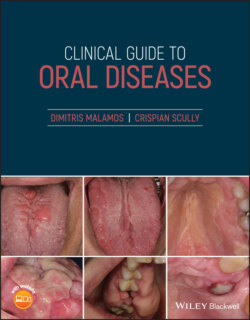Читать книгу Clinical Guide to Oral Diseases - Crispian Scully - Страница 43
Case 3.7
ОглавлениеFigure 3.7
CO: A 64‐year‐old deaf man presented for assessment of a brown lesion on his palate.
HPC: The lesion was asymptomatic and accidentally discovered many years ago during a dental check‐up; it has become slightly bigger and more nodular over the last three months.
PMH: He had got a complete hearing loss due to his premature birth and a history of a healing gastric ulcer, which had being controlled with diet. He was not taken any medicine apart from anti‐acids for stomach pain when needed. His recent clinical and laboratory investigations did not reveal any other serious medical problems. He was an ex‐smoker, but with no history of alcohol use. None of his close relatives had similar oral lesions.
OE: A thin Caucasian male with grade III skin pigmentation, according to the Fitzpatrick scale, presented a diffuse brown discoloration spread out in the middle of his hard palate (Figure 3.7). This pigmentation depicts a color variation as it is lighter at the apex and darker at the center where the mucosa is more nodular. Neither other pigmented lesions in his mouth, other mucosae and skin, nor local lymphadenopathy were detected.
Q1 What is the possible diagnosis of his palatal pigmentation?
1 Melanoma
2 Fixed drug reaction
3 Deep hemangioma
4 Nevus
5 Hemosiderosis
Answers:
1 No
2 No
3 No
4 Melanocytic oral nevus is the answer. It presents as benign isolated, single, or multiple asymptomatic lesions caused by the accumulation of nevus cells within the basal layer, underling the corium or deep in the sub‐mucosa. It appears as flat or slightly raised nodular lesions on the lips, buccal mucosae, palate tongue or gingivae. The color ranges from pale to dark brown, gray, black, or blue and is mainly based on the location of nevi cells and the lesion's duration.
5 No
Comments: Looking at the patient's history, the absence of any systemic diseases or drug uptake responsible for the deposition of iron (hemosiderosis), or other pigments such as melanin (drug induced pigmentation), enables the clinicians to exclude hemosiderosis or drug‐induced pigmentation from the diagnosis. Also, the long duration of the lesion accompanied with no serious complications combined with the clinical characteristics (absence of bleeding or local lymphadenopathy at palpation) excluded melanoma from the first clinical diagnosis, making biopsy the only tool for this to be confirmed.
Q2 Which is the commonest oral melanocytic nevus?
1 Blue nevus
2 Intramucosal nevus
3 Junctional nevus
4 Compound nevus
5 Spitz nevus
Answers:
1 No
2 Intramucosal nevi are the most common nevi in the oral cavity (>65%, of all) and are presented as small (<1 cm), brown, dome‐shaped lesions anywhere in the mouth. This type of nevus is characterized by the accumulation of nevi cells within the lower spinous and basal layers, with no atypia or tendency for melanoma transformation.
3 No
4 No
5 No
Comments: Oral nevi are benign tumors which are mostly noticed in patients over the age of 30 (acquired) and very rarely as a patient's characteristic from birth (congenital), while they are associated with a number of genetic disorders. Intramucosal is the commonest type, followed by the blue (16–35%), compound (6–16.5%) and junctional (3–6%).
Q3 What are the differences between melanocytes and nevi cells?
The differences are in:
1 Morphology
2 Location
3 Origin
4 Organization
5 Functions
Answers:
1 Nevi cells are small, round, dark pigmented cells while the melanocytes are irregular with large dendritic processes and larger cytoplasm full of granules. Dendritic processes are also found in some blue nevi.
2 Melanocytes are located among basal cells of the epithelium, while the nevi cells are additionally found in the upper and lower parts of the submucosa.
3 No
4 Melanocytes are single cells among basal cells, while nevi cells are organized in clusters of up to 30–40 cells.
5 Melanocytes produce melanin for sun protection, while the role of the nevi remains unknown.
Comments: Both cells seem to originate from neural crest cells. Melanocytes initially migrate to the epidermis and settle at the basal layer and in the hair follicles as melanoblasts, which finally mature into melanocytes. Nevi cells originate from melanocytes at the dermo‐epidermal junction and sometimes proliferate and migrate into the sub‐mucosa or from dermal pluripotent congenital precursors
